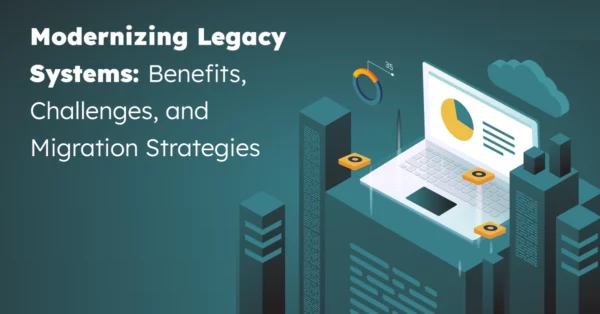
IT Legacy Debt is a significant challenge for many organizations, as it can hinder innovation, increase operational costs, and pose security and compliance risks.
However, with careful planning and a focus on modernization, businesses can address legacy debt over time, reduce their dependency on outdated systems, and unlock the potential of new technologies that can drive growth, efficiency, and competitive advantage. By managing IT legacy debt effectively, companies can ensure that their IT infrastructure supports their long-term strategic goals.
Key Characteristics of IT Legacy Debt:
Outdated Technology:
Legacy systems often involve older software, hardware, or infrastructure that are no longer supported or updated by vendors.
Complexity:
These systems tend to be complex and difficult to modify or integrate with newer technologies, leading to inefficiencies.
High Maintenance Costs:
As technology becomes outdated, maintaining legacy systems requires more time, effort, and resources to keep them operational.
Security Vulnerabilities:
Older systems may not be equipped to handle modern security threats, leaving organizations exposed to cyberattacks or breaches.
Limited Scalability:
Legacy systems are often rigid and can’t easily scale with the growing demands of the business, preventing digital transformation and expansion.
Integration Challenges:
Legacy systems often have trouble integrating with newer technologies, applications, or cloud-based solutions, making it harder to innovate and compete.
Lack of Expertise:
With older systems, there may be a shrinking pool of skilled professionals who know how to work with these technologies, making it harder to troubleshoot or innovate.
How IT Legacy Debt Affects Companies:
Increased Operational Costs:
Maintaining and supporting legacy systems can be costly, especially as hardware and software become obsolete. These systems may require frequent patches, manual interventions, and specialist knowledge, increasing labor costs and downtime.
Example: A company relying on outdated ERP software may have to pay high support fees or hire expensive consultants to address issues, rather than investing in more modern, cost-effective solutions.
Reduced Agility and Innovation:
Legacy systems are often inflexible and slow to adapt to new business needs. This lack of agility can hinder a company’s ability to innovate, launch new products, or respond quickly to market changes.
Example: A company with an old CRM system may struggle to integrate it with new marketing tools, preventing them from delivering personalized customer experiences or taking advantage of new automation technologies.
Increased Security Risks:
Outdated systems are more vulnerable to cyberattacks because they may lack modern security features and protections. Organizations that continue to rely on legacy systems are at risk of data breaches, hacking, and compliance violations.
Example: A company using an old operating system with known security flaws could be targeted by ransomware attacks, resulting in data loss and financial damage.
Compliance Challenges:
Many industries require strict adherence to regulatory standards (e.g., GDPR, HIPAA, PCI-DSS). Legacy systems often struggle to meet these compliance requirements, leading to potential legal issues, fines, or reputational damage.
Example: A financial institution relying on outdated systems might face difficulties in implementing the necessary data protection controls to comply with regulations like GDPR, risking non-compliance penalties.
Difficulty in Scaling:
As businesses grow, their IT infrastructure must scale accordingly. Legacy systems often lack the scalability needed to accommodate increased data, transactions, or user demand. This can impede business growth and innovation.
Example: A company that continues to use a legacy inventory management system may struggle to handle the increased volume of products and customers during a period of expansion, leading to inefficiencies or missed opportunities.
Poor User Experience:
Outdated systems may not provide a user-friendly interface or the performance needed to meet modern expectations. This can result in employee frustration, decreased productivity, or poor customer experiences.
Example: An employee using a clunky, legacy internal system might take longer to perform basic tasks, impacting productivity and morale.
Difficulty Integrating with Modern Tools:
Legacy systems can have trouble connecting with newer technologies or cloud-based applications. This lack of interoperability can make it harder for companies to take advantage of emerging technologies and improve overall efficiency.
Example: A company using a legacy accounting system might find it challenging to integrate with modern e-commerce platforms, which could delay order processing or financial reporting.
Talent Retention and Knowledge Gaps:
With legacy systems, companies may struggle to retain or attract top talent. As younger professionals may not be familiar with outdated technologies, organizations might face challenges in building a workforce capable of supporting the legacy environment.
Example: A company that relies on an old programming language for its software might struggle to find developers who are proficient in that language, leading to a reliance on older, more expensive resources.
How to Manage IT Legacy Debt:
Identify Legacy Systems:
Conduct an audit to identify outdated systems, applications, or technologies that are contributing to legacy debt. This assessment should prioritize systems based on their business impact and the risks they pose.
Prioritize Modernization:
Focus on replacing or upgrading the most critical systems first. This could involve migrating legacy applications to the cloud, adopting new software solutions, or modernizing IT infrastructure to improve scalability, security, and efficiency.
Adopt Agile Practices:
Implement more flexible and iterative approaches to IT development. Agile practices can help businesses gradually transition from legacy systems to modern solutions without disrupting daily operations.
Cloud Migration:
Moving from on-premises legacy infrastructure to cloud-based solutions can help reduce IT debt. Cloud solutions offer scalability, flexibility, and cost-effectiveness, enabling businesses to modernize without a major upfront investment.
Invest in Training and Reskilling:
Providing training for employees on new technologies and processes can help bridge the gap between legacy systems and modern IT solutions. Encourage knowledge transfer and upskilling to reduce dependency on outdated systems.
Gradual Transition:
Instead of a sudden overhaul, businesses can consider a phased approach to replacing legacy systems. This allows for a smoother transition and minimizes disruption to operations.
Engage Expert Consultants:
Bringing in external consultants who specialize in legacy system modernization can provide valuable insights and expertise on how to approach the problem and make the transition more efficient.



